For the 2025 school year, there is 1 public elementary school serving 397 students in Coosa County School District. This district's average elementary testing ranking is 3/10, which is in the bottom 50% of public elementary schools in Alabama.
Public Elementary School in Coosa County School District have an average math proficiency score of 17% (versus the Alabama public elementary school average of 28%), and reading proficiency score of 35% (versus the 49% statewide average).
Minority enrollment is 48% of the student body (majority Black), which is less than the Alabama public elementary school average of 49% (majority Black).
Overview
This School District
This State (AL)
# Schools
2 Schools
1,080 Schools
# Students
781 Students
515,920 Students
# Teachers
45 Teachers
29,146 Teachers
Student : Teacher Ratio
17:1
17:1
District Rank
Coosa County School District, which is ranked within the bottom 50% of all 145 school districts in Alabama (based off of combined math and reading proficiency testing data) for the 2021-2022 school year.
The school district's graduation rate of 70-79% has decreased from 80-84% over five school years.
Overall District Rank
#111 out of 145 school districts
(Bottom 50%)
(Bottom 50%)
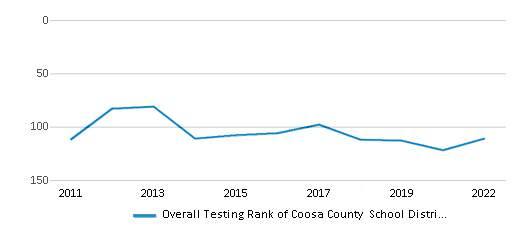
Math Test Scores (% Proficient)
12%
29%

Reading/Language Arts Test Scores (% Proficient)
38%
47%
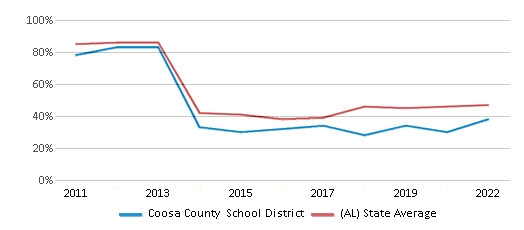
Science Test Scores (% Proficient)
20-24%
38%
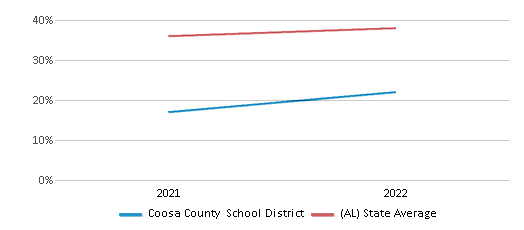
Graduation Rate
70-79%
88%

Students by Ethnicity:
Diversity Score
0.59
0.63
# American Indian Students
1 Student
4,587 Students
% American Indian Students
n/a
1%
# Asian Students
n/a
7,150 Students
% Asian Students
n/a
2%
# Hispanic Students
49 Students
57,112 Students
% Hispanic Students
6%
11%
# Black Students
311 Students
161,465 Students
% Black Students
40%
31%
# White Students
396 Students
263,748 Students
% White Students
51%
51%
# Hawaiian Students
1 Student
582 Students
% Hawaiian Students
n/a
n/a
# Two or more races Students
23 Students
21,276 Students
% of Two or more races Students
3%
4%
Students by Grade:
# Students in PK Grade:
-
20,227
# Students in K Grade:
56
54,285
# Students in 1st Grade:
65
58,528
# Students in 2nd Grade:
58
57,991
# Students in 3rd Grade:
61
55,161
# Students in 4th Grade:
57
54,229
# Students in 5th Grade:
48
54,176
# Students in 6th Grade:
52
54,851
# Students in 7th Grade:
80
40,400
# Students in 8th Grade:
60
39,777
# Students in 9th Grade:
62
7,285
# Students in 10th Grade:
67
6,720
# Students in 11th Grade:
55
6,390
# Students in 12th Grade:
60
5,900
# Ungraded Students:
-
-
District Revenue and Spending
The revenue/student of $15,175 is higher than the state median of $13,006. The school district revenue/student has stayed relatively flat over four school years.
The school district's spending/student of $13,506 is higher than the state median of $12,220. The school district spending/student has stayed relatively flat over four school years.
Total Revenue
$12 MM
$9,671 MM
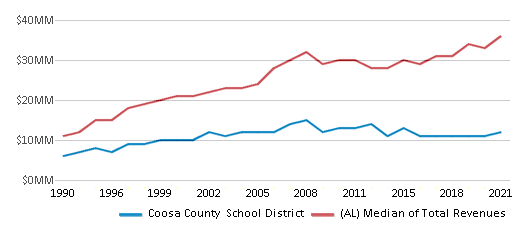
Spending
$11 MM
$9,086 MM

Revenue / Student
$15,175
$13,006
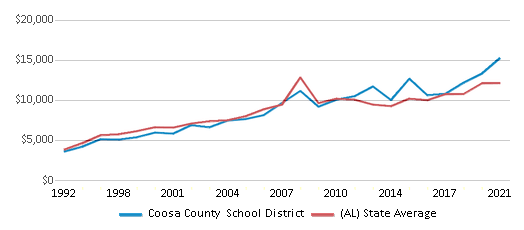
Spending / Student
$13,506
$12,220
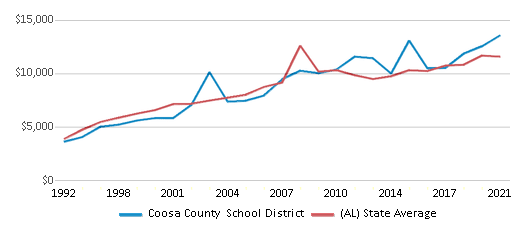
Best Coosa County School District Public Elementary Schools (2025)
School
(Math and Reading Proficiency)
(Math and Reading Proficiency)
Location
Grades
Students
Rank: #11.
Central Elementary School
(Math: 17% | Reading: 35%)
Rank:
Rank:
4/
Bottom 50%10
95 Coosa County Rd 75
Rockford, AL 35136
(256) 377-1456
Rockford, AL 35136
(256) 377-1456
Grades: K-6
| 397 students
Recent Articles

Year-Round Or Traditional Schedule?
Which is more appropriate for your child? A year-round attendance schedule or traditional schedule? We look at the pros and cons.

Why You Should Encourage Your Child to Join a Sports Team
Participating in team sports has a great many benefits for children, there is no doubt. In this article you will learn what those benefits are.

White Students are Now the Minority in U.S. Public Schools
Increasing birth rates among immigrant families from Asia and Central and South America, combined with lower birth rates among white families, means that for the first time in history, public school students in the United States are majority-minority. This shift in demographics poses difficulties for schools as they work to accommodate children of varying language abilities and socio-economic backgrounds.





